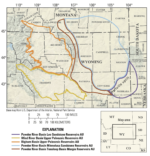
Tuesday, July 8th, 2025
Melting glaciers worldwide are significant indicators of climate change, revealing dynamic shifts in Earth’s environment. Satellite technology plays a crucial role in tracking these changes by measuring glacier movement and mass balance to assess climate impacts. Glaciers are dynamic and sensitive geosystems that respond to human-driven climate changes, constantly moving and evolving rather than being

Monday, June 23rd, 2025
Below ocean wind farms, oil rigs and other offshore installations are mammoth networks of underwater structures, including pipelines, anchors, risers and cables, that are essential to harness the energy source. But much like terrestrial structures, these subsea constructions are also vulnerable to natural events, like submarine landslides, that can hamper the productivity of installations below

Friday, June 6th, 2025
A lot can change in a year for Earth’s forests and vegetation, as springtime and rainy seasons can bring new growth, while cooling temperatures and dry weather can bring a dieback of those green colors. And now, a novel type of NASA visualization illustrates those changes in a full complement of colors as seen from

Tuesday, May 27th, 2025
RoGO Communications and LBiSat are partnering to deliver GPS tracking and remote connectivity for situational awareness and tactical collaboration for a common operational picture. LBiSat provides satellite communications using Continuity+ and Personal Cell Tower to Incident Command Posts to establish and manage emergency responses. LBiSat provides a full range of business continuity and disaster

Tuesday, May 13th, 2025
On May 7, 2025, the Ocean Exploration Trust exploration vessel Nautilus sets sail on its first expedition of 2025 to explore the ocean surrounding the Mariana Islands. This region is largely shaped by the forces of plate tectonics, with some of the oldest seafloor on the planet being driven into the Mariana Trench (the deepest ocean trench) and then

Saturday, April 26th, 2025
As part of a science mission tracking one of Earth’s most precious resources–water–NASA’s C-20A aircraft conducted a series of seven research flights in March that can help researchers track the process and timeline as snow melts and transforms into a freshwater resource. The agency’s Uninhabited Aerial Vehicle Synthetic Aperture Radar (UAVSAR) installed on the aircraft

Monday, April 14th, 2025
Even in the far north and in a wet climate, Norway’s Ålfotbreen glacier is rapidly shrinking. This glacier grew as recently as the 1990s but has been getting smaller since then due to more frequent and intense heat waves. Scientists have found that ice loss from mountain glaciers globally has been speeding up over time. Image

Monday, March 31st, 2025
Launched just seven months ago, ESA’s Arctic Weather Satellite has been proving how the New Space approach can accelerate the development of missions capable of delivering detailed temperature and humidity profiles for short-term weather forecasts. Moreover, the impact of this small prototype satellite goes even further–remarkably, its measuring instrument has been recognised as able to provide data

Tuesday, March 18th, 2025
The U.S. Geological Survey (USGS) assessed that the upper Paleozoic reservoirs of the Wind River, Bighorn and Powder River basins has technically recoverable resources of 47 million barrels of oil and 876 billion cubic feet of gas. This area includes Wyoming and parts of southern Montana as well as parts of western South Dakota and Nebraska. Since exploration

Tuesday, March 4th, 2025
In the wake of the aircraft collision over the Potomac River near Ronald Reagan Washington National Airport (DCA), NOAA’s National Ocean Service activated response teams to support response and recovery efforts. Tragically, the incident claimed all 67 lives aboard the two aircraft and created significant recovery and salvage obstacles due to the frigid waters and complex wreckage
